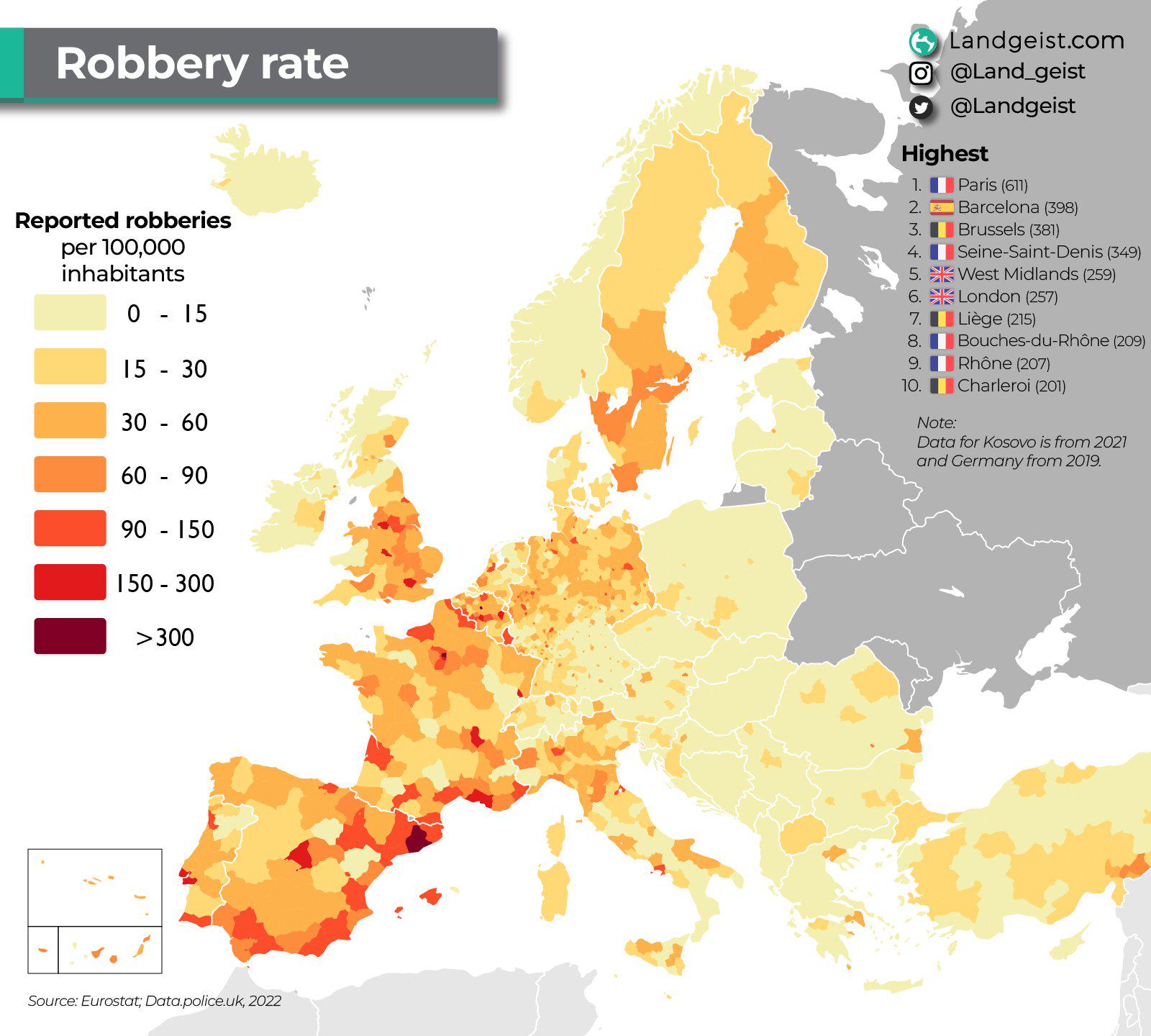Robbery Rate in Europe Map


David Chen
Data Visualization Specialist
David Chen is an expert in transforming complex geographic datasets into compelling visual narratives. He combines his background in computer science ...
Geographic Analysis
What This Map Shows
The "Robbery Rate in Europe Map" visually represents the prevalence of robbery incidents across various European countries in 2022. By examining this map, we can gain insights into crime trends, regional safety perceptions, and socio-economic factors that may contribute to these statistics. This information is vital for understanding not only the criminal landscape of Europe but also how different regions react to and manage crime.
Deep Dive into Robbery Rates in Europe
Robbery, defined as the unlawful taking of property from a person through force or intimidation, significantly impacts communities and their economic stability. The data from 2022 reveals a complex picture of robbery rates across Europe, showcasing both high and low incidences that can often be attributed to various socio-economic conditions.
Interestingly, European countries exhibit a wide range of robbery rates, influenced by factors such as urbanization, economic disparity, and law enforcement efficiency. For instance, countries like Sweden and Norway generally report lower robbery rates, which can be linked to their strong social safety nets and effective policing strategies. On the other end, nations such as France and Spain show higher instances of robbery, often associated with urban centers where crime can be more prevalent due to higher population density and economic challenges.
In terms of numbers, a report from Eurostat indicated that in 2022, the robbery rate in Sweden was approximately 1.4 incidents per 1,000 inhabitants, while in Spain, it surged to 3.4 incidents per 1,000 inhabitants. This stark contrast raises the question: what underlying factors contribute to these differences? Urban areas, particularly in larger cities, often face higher robbery rates. This is not merely a reflection of crime prevalence but also highlights the challenges of urban management and socio-economic inequality.
Moreover, the types of robbery can vary significantly. In some countries, street robberies are more common, while in others, residential burglaries may dominate. Understanding these nuances is crucial for policymakers aiming to combat crime effectively. For instance, targeted interventions in high-risk neighborhoods can reduce robbery rates and increase public safety.
Regional Analysis
When we break down the robbery rates by region, intriguing patterns emerge. Northern Europe, particularly the Nordic countries, tends to have lower robbery rates. This can be attributed to their comprehensive welfare systems, which provide a safety net for citizens, thus potentially reducing the motivation for committing theft. Sweden, Norway, and Finland all demonstrate a commitment to social equity, which correlates with lower crime rates.
In contrast, Southern European countries, such as Italy and Greece, show higher robbery rates. Factors such as high unemployment rates, economic instability, and urban poverty contribute to this trend. For example, in Italy, certain cities like Naples report significantly elevated robbery figures, often tied to organized crime networks and social disparities.
Eastern Europe presents another layer of complexity. Countries like Romania and Bulgaria experience higher robbery rates compared to their Western counterparts, influenced by transitional economies and differing law enforcement practices. The map shows that while these countries face challenges, they are also making strides in improving public safety and reducing crime through various initiatives.
Interestingly, the map also highlights urban versus rural disparities. Urban areas across Europe often report higher robbery rates due to factors such as anonymity and increased opportunity for crime. In contrast, rural areas tend to have lower rates, likely due to close-knit communities and lower population density.
Significance and Impact
Understanding robbery rates in Europe is not just about statistics; it has profound implications for public policy and community safety. High robbery rates can lead to increased fear among residents, potentially affecting their quality of life and economic stability. Furthermore, they can influence tourist perceptions, impacting local economies reliant on visitors.
What's fascinating is how the approach to combating robbery varies widely across Europe. Some countries are investing in technology, such as surveillance and predictive policing, while others focus on community engagement and preventative measures. The effectiveness of these strategies in reducing robbery rates could provide essential insights for countries struggling with higher crime rates.
As we look to the future, trends suggest an increasing reliance on data-driven approaches to combat crime. With advancements in technology and data analysis, law enforcement agencies can better understand crime patterns and allocate resources more effectively. However, addressing the root causes of robbery, including poverty and social inequality, remains crucial for long-term solutions.
Ultimately, the "Robbery Rate in Europe Map" serves as a crucial tool for policymakers, researchers, and citizens alike, offering a snapshot of crime that can drive meaningful discussion and action. By continuing to monitor these trends and understanding their underlying causes, Europe can move towards safer communities for all its residents.
Visualization Details
- Published
- August 11, 2025
- Views
- 144
Comments
Loading comments...